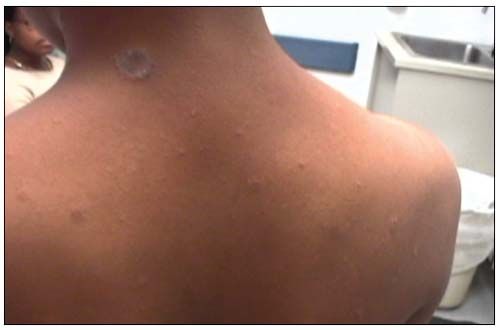Pityriasis Rosea in Dark-Skinned Children
In the course of studying azithromycin as a treatment for pityriasis rosea (PR) which we found does not work, we collected much data on the distribution, morphology, and course of the lesions.
In the course of studying azithromycin as a treatment for pityriasis rosea (PR),1 which we found does not work, we collected much data on the distribution, morphology, and course of the lesions.2 We also amassed many photos, some of which appear in this Photo Essay. These photos highlight the various presentations of PR in African American children, which we discovered are often different from the standard “textbook” descriptions.

Figure 1 – The herald patch on the neck and classic lesions on the back of this patient are characteristic of pityriasis rosea.
We followed the natural history of PR in 50 African American children in the United States.2 The data included the presence and location of a herald patch, duration of lesions, number of lesions, types and distribution of lesions, and presence of pruritus. The PR lesions involved the trunk in all patients, neck in 44%, face in 30%, arms and forearms in 60%, thighs and legs in 54%, pelvis or groin in 12%, and scalp in 8%. Almost all (90%) of our patients had pruritus. See Figures 1 to 7 for the clear-cut differences between our results and what pediatricians read in textbooks about PR. It is worth keeping in mind that the usual description of PR applies mainly to white patients.
References:
REFERENCES:
1. Amer A, Fischer H. Azithromycin does not cure pityriasis rosea. Pediatrics. 2006;117:1702-1705.
2. Amer A, Fischer H, Li X. The natural history of pityriasis rosea in black American children: how correct is the “classic” description? Arch Pediatr Adolesc Med. 2007;161:503-506.
Recognize & Refer: Hemangiomas in pediatrics
July 17th 2019Contemporary Pediatrics sits down exclusively with Sheila Fallon Friedlander, MD, a professor dermatology and pediatrics, to discuss the one key condition for which she believes community pediatricians should be especially aware-hemangiomas.